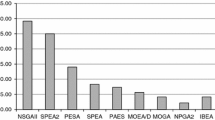Abstract
The performance of an optimization tool is largely determined by the efficiency of the search algorithms used in the process as well as the proper handling of complex constraints. From the implementation point of view, an important part of task ensuring an efficient algorithm to work to its best capability is to handle the boundary constraints properly and effectively. As most studies in the literature have focused on the development of algorithms and performance evaluation and comparison of optimization algorithms, this crucial step has not been explored very well, and consequently only limited studies have been carried out in this field. This paper intends to propose a simple and yet efficient evolutionary scheme for handling boundary constraints. The simplicity of this approach means that the proposed scheme is very easy to implement and thus can be suitable for many applications. We demonstrate this approach with an efficient algorithm, differential evolution, and we also compare it with other boundary constraint handling approaches for a wide set of benchmark problems. Based on statistical parameters and especially mean values, the results obtained by the evolutionary scheme are better than the best known solutions obtained by the existing methods.





Similar content being viewed by others
Explore related subjects
Discover the latest articles and news from researchers in related subjects, suggested using machine learning.References
Yang XS (2010) Nature-inspired metaheuristic algorithms, 2nd Ed., Luniver Press, Bristol
Gandomi AH, Alavi AH, Herd K (2012) A new bio-inspired optimization algorithm. Commun Nonlinear Sci Numer Simul. doi:10.1016/j.cnsns.2012.05.010
Yang XS (2010) Engineering optimization: an introduction with metaheuristic applications. Wiley, London
Michalewicz Z (1995) A survey of constraint handling techniques in evolutionary computation methods. In: proceedings of 4th annual conference on evolutionary programming, MIT Press, Cambridge MA, pp 135–155
Goldberg DE (1975) The design of innovation: lessons from and for Competent Genetic Algorithms, Addison-Wesley, Reading, MA, 2002. J. Holland, Adaptation in natural and artificial systems, University of Michigan Press, Ann Anbor
Holland J (1975) Adaptation in natural and artificial systems. University of Michigan Press, Ann Anbor
De Jong K (1975) Analysis of the behaviour of a class of genetic adaptive systems, PhD thesis, University of Michigan, Ann Anbor
Gandomi AH, Alavi AH (2011) Multi-stage genetic programming: a new strategy to nonlinear system modeling. Inf Sci 181:5227–5239
Price K, Storn R, Lampinen J (2005) Differential evolution: a practical approach to global optimization, Springer, Berlin
Storn R, Price KV (1997) Differential evolution—a simple and efficient heuristic for global optimization over continuous spaces. J Global Optim 11(4):341–359
Nejat Pishkenari H, Mahboobi SH, Alasty A (2011) Optimum synthesis of fuzzy logic controller for trajectory tracking by differential evolution. Scientia Iranica 18(2):261–267
Gandomi AH, Yang XS, Talatahari S, Deb S (2012) Coupled eagle strategy and differential evolution for unconstrained and constrained global optimization. Comput Math Appl 63(1):191–200
Huang T, Mohan AS (2005) A hybrid boundary condition for robust particle swarm optimization. IEEE Antennas Wirel Propag Lett 4:112–117
Xu S, Rahmat-Samii Y (2007) Boundary conditions in particle Swarm optimization revisited. IEEE Trans Antennas Propag 55(3):112–117
Chen TY, Chi TM (2010) On the improvements of the particle swarm optimization algorithm. Adv Eng Softw 41:229–239
Chu W, Gao X, Sorooshian S (2011) Handling boundary constraints for particle swarm optimization in high-dimensional search space. Inf Sci 181(20):4569–4581
Kaveh A, Talatahari S (2009) Particle swarm optimizer, ant colony strategy and harmony search scheme hybridized for optimization of truss structures. Comput Struct 87(5–6):267–283
Ali MM, Khompatraporn C, Zabinsky ZB (2005) A numerical evaluation of several stochastic algorithms on selected continuous global optimization test problems. J Global Optim 31:635–672
Author information
Authors and Affiliations
Corresponding author
Appendices
Appendix 1: Detailed formulation of the benchmark problems
F1: Ackley Function
F2: Becker and Lago Function
F3: Branin Function
where
F4: Dekkers and Aarts Function
F5: Easom Function
F6: Goldstein and Price Function
F7: Griewank Function
F8: Hartman 3 Function (Table 3)
F9: Hartman 6 Function (Table 4)
F10: Hosaki Function (Table 5)
F11: Kowalik Function
F12: Levy and Montalvo 1 Function
F13: Levy and Montalvo 2 Function
F14: Modified Langerman Function (Table 6)
F15: Neumaier 3 Function
F16: Paviani Function
F17: Rastrigin Function
F18: Rosenbrock Function
F19: Shekel’s Foxholes Function (Table 7)
F20: Wood Function
Appendix 2
See Table 8.
Rights and permissions
About this article
Cite this article
Gandomi, A.H., Yang, XS. Evolutionary boundary constraint handling scheme. Neural Comput & Applic 21, 1449–1462 (2012). https://doi.org/10.1007/s00521-012-1069-0
Received:
Accepted:
Published:
Issue Date:
DOI: https://doi.org/10.1007/s00521-012-1069-0




